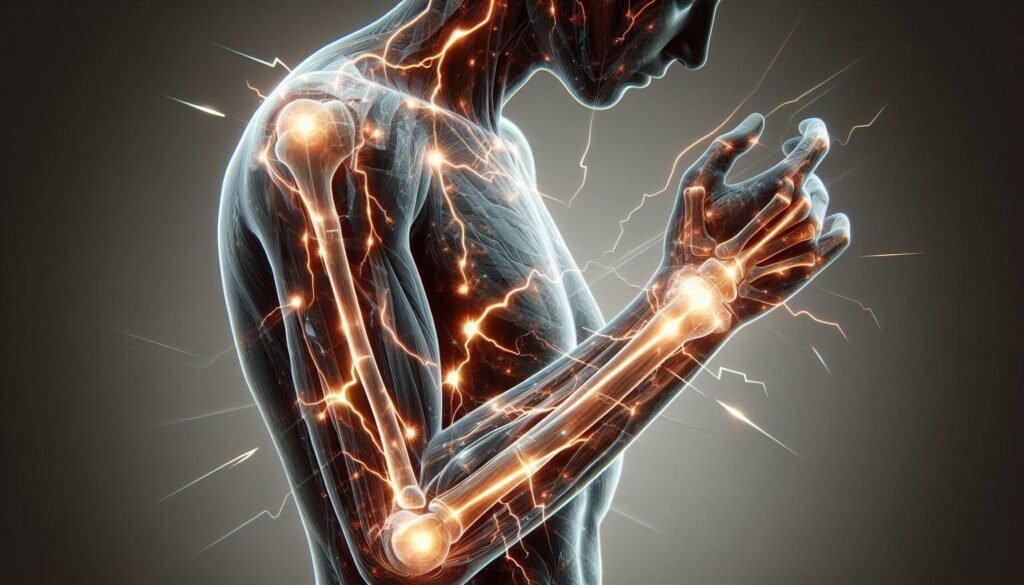Introduction to Genetics and Its Role in Neurological Disorders
Paresthesia, the tingling or numb sensation often felt in limbs, is more than just a fleeting discomfort. For many, it can signify deeper neurological issues rooted in genetics. Understanding the genetic factors in paresthesia has profound implications for diagnosis and treatment options. As research advances, scientists are uncovering how hereditary conditions can contribute to these sensations we often take for granted.
Genetics plays a crucial role in various neurological disorders, shaping not only susceptibility but also severity and progression of symptoms. With increasing awareness of how our DNA influences nerve function, it’s essential to explore what science says about these genetic connections to paresthesia. This journey into the world of genes may shed light on potential therapies that could improve countless lives affected by this perplexing condition. Join us as we delve into the fascinating interplay between genetics and paresthesia!

Hereditary Neuropathies: Charcot-Marie-Tooth Disease and Paresthesia
Charcot-Marie-Tooth Disease (CMT) is one of the most common hereditary neuropathies. It primarily affects peripheral nerves, leading to muscle weakness and sensory loss. Paresthesia, characterized by tingling or numbness in extremities, often accompanies this condition.
The genetic basis of CMT varies significantly. Different gene mutations can lead to distinct subtypes of the disease. For instance, CMT type 1A is linked to a duplication on chromosome 17 affecting the PMP-22 gene. This mutation disrupts myelin production around nerve fibers.
Symptoms typically manifest during adolescence or early adulthood but may appear later in life as well. The progression can vary widely among individuals even within families carrying the same mutation.
Management strategies focus on symptom relief and improving quality of life. Physical therapy and orthopedic interventions are common approaches that help patients maintain mobility despite their challenges with paresthesia.
Familial Amyloid Polyneuropathy: A Genetic Cause of Paresthesia
Familial Amyloid Polyneuropathy (FAP) is a genetic condition that significantly impacts nerve function. It arises from mutations in genes responsible for producing proteins, particularly transthyretin (TTR). When TTR misfolds, it forms amyloid deposits that accumulate in peripheral nerves and other tissues.
These amyloid deposits disrupt normal nerve signaling, leading to sensations of tingling or numbness—commonly referred to as paresthesia. Symptoms can begin subtly but often progress to more severe neurological issues over time. Patients may experience pain, weakness, and loss of autonomic functions.
The inheritance pattern of FAP is typically autosomal dominant. This means that only one copy of the mutated gene from an affected parent can lead to the disorder in offspring. Genetic screening plays a crucial role in identifying at-risk individuals before symptoms manifest.
Understanding FAP not only helps patients navigate their experiences with paresthesia but also guides medical professionals toward targeted interventions and management strategies tailored specifically for this hereditary condition.
Mitochondrial Disorders and Their Impact on Nerve Function
Mitochondrial disorders are a group of diseases that arise from dysfunctional mitochondria. These organelles, known as the powerhouses of the cell, generate energy crucial for cellular functions. When they fail, it significantly affects various systems in the body, particularly nerve function.
Nerve cells require substantial amounts of energy to maintain their complex processes. Mitochondrial dysfunction can lead to impaired neurotransmission and reduced neuronal survival. This may manifest as paresthesia—abnormal sensations such as tingling or numbness.
Symptoms often vary widely depending on which nerves are affected and the severity of mitochondrial impairment. Patients might experience muscle weakness, sensory abnormalities, or even cognitive issues due to compromised nerve health.
Current research continues to explore potential therapeutic strategies targeting mitochondrial function. By improving energy production within these cells, scientists hope to alleviate some symptoms associated with neurological complications linked to mitochondrial disorders.
Genetic Mutations Affecting Ion Channels and Paresthesia
Genetic mutations can significantly impact ion channels, leading to various neurological conditions, including paresthesia. Ion channels are crucial proteins in nerve cells that regulate the flow of ions such as sodium and potassium. Disruptions in their function can alter neuronal excitability.
One well-studied group of genetic mutations affecting ion channels involves the voltage-gated sodium channels. Mutations in genes like SCN9A have been linked to altered sensations and pain perception, resulting in conditions characterized by abnormal tingling or numbness.
Additionally, certain calcium channel mutations may lead to hereditary neuropathies that also manifest with paresthetic symptoms. These changes can inhibit proper nerve signal transmission, causing discomfort and sensory abnormalities.
Understanding these genetic factors offers insight into how specific mutations contribute to paresthesia. Ongoing research continues to explore the relationship between ion channel dysfunctions and their broader implications for treating related disorders effectively.
The Role of Genetic Testing in Diagnosing Hereditary Paresthesia
Genetic testing plays a crucial role in diagnosing hereditary paresthesia, offering insights into the underlying genetic causes. By examining an individual’s DNA, healthcare providers can identify specific mutations linked to various neuropathies. This is particularly valuable for patients who experience unexplained or progressive symptoms.
Through targeted tests, clinicians can determine if conditions such as Charcot-Marie-Tooth disease or familial amyloid polyneuropathy are present. Identifying these disorders early allows for timely interventions and better management strategies tailored to individual needs.
Moreover, genetic testing not only aids in diagnosis but also helps differentiate between inherited and acquired forms of paresthesia. Understanding the genetic background can significantly influence treatment decisions and prognostic outcomes.
As technology advances, the accessibility of genetic testing continues to improve. This shift empowers families with knowledge about their health risks and enables more informed choices regarding lifestyle and medical care related to neuropathic conditions.
Epigenetics: How Environment Influences Genetic Expression of Paresthesia
Epigenetics is a fascinating field that examines how environmental factors can influence genetic expression. This means that while our DNA provides the blueprint for our bodies, external elements can modify how these genes behave. Such modifications play a crucial role in various neurological conditions, including paresthesia.
Research indicates that stress, diet, and exposure to toxins may affect gene expression related to nerve function. For example, individuals living in high-stress environments might experience heightened sensitivity or changes in nerve signaling due to epigenetic alterations. These changes can lead to symptoms like tingling or numbness more frequently than in less stressful situations.
Moreover, nutritional deficiencies can also impact gene regulation. A lack of essential vitamins and minerals necessary for nerve health might amplify the effects of already existing genetic predispositions towards paresthesia.
Understanding these interactions opens new doors for targeted therapies aimed at mitigating symptoms through lifestyle adjustments and environmental interventions.
Genetic Counseling for Families with Hereditary Neuropathies
Genetic counseling plays a crucial role for families dealing with hereditary neuropathies. These conditions often have complex genetic underpinnings, making it essential to understand the inheritance patterns and potential implications for family members. A trained genetic counselor can help clarify these aspects and provide personalized information.
During sessions, counselors assess family histories to identify risks of passing on specific disorders. They discuss testing options that can confirm or rule out diagnoses, which is particularly valuable in conditions like Charcot-Marie-Tooth disease or familial amyloid polyneuropathy.
Counselors also guide families through the emotional challenges associated with hereditary neuropathies. Discussing future health concerns may provoke anxiety; hence, support mechanisms are vital during this process.
Furthermore, they offer resources about available treatment options and ongoing research developments that could impact patient care down the line. This comprehensive approach empowers families to make informed decisions regarding their health management strategies.
Current Research on Genetic Therapies for Neuropathic Conditions
Current research in genetic therapies for neuropathic conditions is advancing rapidly. Scientists are exploring innovative approaches to treat disorders like Charcot-Marie-Tooth disease and familial amyloid polyneuropathy. These efforts focus on correcting or compensating for the underlying genetic mutations that contribute to nerve damage.
Gene editing technologies, particularly CRISPR-Cas9, are at the forefront of these developments. Researchers aim to make precise modifications in genes responsible for neuropathies. This could potentially restore normal function and alleviate symptoms such as paresthesia.
Additionally, gene therapy strategies involve delivering healthy copies of genes into patients’ cells. This method shows promise in addressing various hereditary neuropathies by providing the necessary proteins required for proper nerve functioning.
Clinical trials are underway to evaluate safety and efficacy across different populations. As our understanding deepens, tailored treatments may become available, offering hope for individuals suffering from genetic forms of paresthesia and other related conditions.
Future Perspectives: Personalized Medicine for Genetic Paresthesia
The field of personalized medicine holds remarkable potential for addressing genetic factors in paresthesia. As research continues to evolve, the future may herald targeted treatments designed specifically for individuals based on their unique genetic profiles. This approach could transform how clinicians manage neuropathic conditions linked to hereditary factors.
Current advancements are paving the way for gene therapies that aim to correct or compensate for dysfunctional genes responsible for nerve impairment and associated symptoms. Additionally, pharmacogenomics—the study of how genes affect a person’s response to drugs—could lead to more effective treatment plans tailored to individual needs.
Integrating these approaches into clinical practice will require collaboration among researchers, healthcare providers, and patients. With ongoing studies exploring various genetic mutations affecting ion channels and other pathways involved in paresthesia, the landscape is ripe with opportunities for innovative solutions.
As we deepen our understanding of both genetics and environmental influences on disease manifestation, it becomes increasingly clear that personalized interventions can significantly improve quality of life for those affected by genetic forms of paresthesia. The future looks promising as science inches closer towards unlocking individualized care strategies in managing this complex condition.


